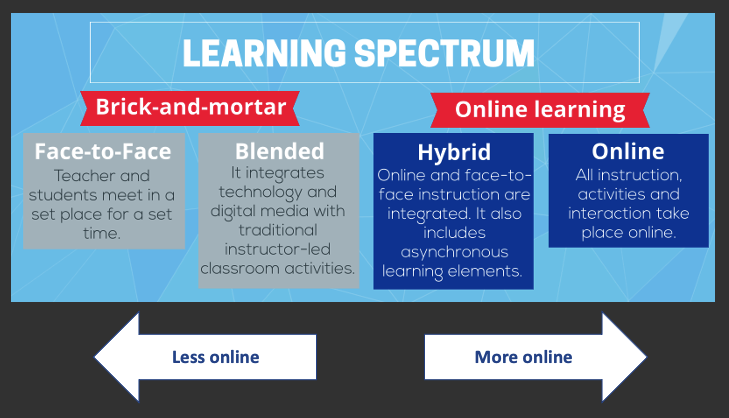Category: Teaching
Here are seven mistakes by teachers that cause us to be less effective:
1. Trying to re-create face-to-face learning in online learning
Attempts to re-create the brick-and-mortar classroom learning experience, methods, and modes to the online environment is a basic error. Is online better than F2F? If you are asking this question, you should probably continue teaching F2F.
Teaching online requires a "start over" in your course design, though not necessarily a change in student learning outcomes. The effectiveness of online pedagogy is based on how the mode of communication is used, the instructional design, and the interaction between learners.
Communication should be multimodal. It can be offered through print or text media as well as audio or video. It's the same information, just provided in multiple and consistent ways. It would be ideal if all teachers in the same school could use the same platform.
Technologies such as WhatsApp, Telegram, Facebook messenger, Learning Management System (LMS), email, and video chat applications like Skype and Google Meet have made communication between teacher and learner more timely, efficient, and productive.
Technologies such as WhatsApp, Telegram, Facebook messenger, Learning Management System (LMS), email, and video chat applications like Skype and Google Meet have made communication between teacher and learner more timely, efficient, and productive.
In the first few days of teaching online, we have to build social-emotional skills of learners to increase their motivation. There is a strong connection between mental health and academic success because poor mental health can negatively influence learners’ ability to learn.
Besides, a vital part of the process is teaching learners how to use technology tools to send and receive the assignments as part of the course.
2. Attempting to go for coverage rather than depth
Online learning requires a higher level of student engagement than F2F learning. So, reduce the number of contents and focus on assignments to help learners achieve the most important learning outcomes. Learners who study fewer topics, but study them in greater depth, are more successful in academics over their peers who study more topics and spend less time on each.
3. Taking attendance
Attendance is an archaic and almost meaningless metric in distance learning. Many teachers are monitoring learners' engagement and who is submitting assignments rather than daily attendance because not all learners are able to participate in online learning. Besides, many of them are facing additional barriers than others, like caring siblings, Wi-Fi issues, and financial problems.
Here are a few engagement measures to consider:
- Are learners logging on often?
- Are they submitting their work on time?
- Are they asking questions and seeking additional resources?
- Are they responding to feedback?
4. Explaining the task but actually not teaching
Writing documents and recording videos with a bunch of instructions for the lesson won't help, especially if the learners will need more input on a topic. Finding the best way to deliver your content and get your learners to understand you in a face-to-face teaching environment can be challenging. Doing that in an online environment can be even more challenging due to different distractions at home.
Using different content types can help minimize distractions and keep students engaged in the learning content.
Here's a list of content types:
Here's a list of content types:
|
|
5. Using long videos
Videos are an important feature of many online courses. Replacing your lectures with self-made videos can boost learners’ engagement and free you up to work with them directly. Video allows teachers to save hours of repetitive teaching.
For many teachers, flipping the classroom begins with live recording their lectures. Sending recorded lectures to learners allows them to pause and rewatch if they didn’t understand it the first time. With recorded lectures, learners will be able to pause the video, rewatch the lesson multiples times according to their learning pace and needs. Also, by adding images and sounds, it is possible to approach learners and make them more interested in what is being taught.
Research on instructional videos shows that learner engagement with videos begins to drop after the 6-minute mark, so multiple short videos are better than one long video instead.
Here's a list of free video editors online:
Research on instructional videos shows that learner engagement with videos begins to drop after the 6-minute mark, so multiple short videos are better than one long video instead.
Here's a list of free video editors online:
6. Not giving meaningful feedback
As your learners are learning from a distance, it is important that they receive consistent feedback on their progress. If they receives a 100 or a 75, that doesn’t necessarily tell them as much as verbal feedback or print feedback, so really there’s going to be an emphasis on teachers giving learners feedback rather than their grades.
If there is no feedback loop taking place though, learners and parents have no way of knowing what they have done well nor what their next steps are. It also gives the impression that the teacher doesn’t care about the tasks being completed by the student.
If there is no feedback loop taking place though, learners and parents have no way of knowing what they have done well nor what their next steps are. It also gives the impression that the teacher doesn’t care about the tasks being completed by the student.
7. Failing to ask for help
Online teaching comes with its own challenges. Traditionally, teachers develop their courses alone but in online learning, especially for first-time instructors, is a great opportunity to be more collaborative in our approach to teaching. Ask for help.









